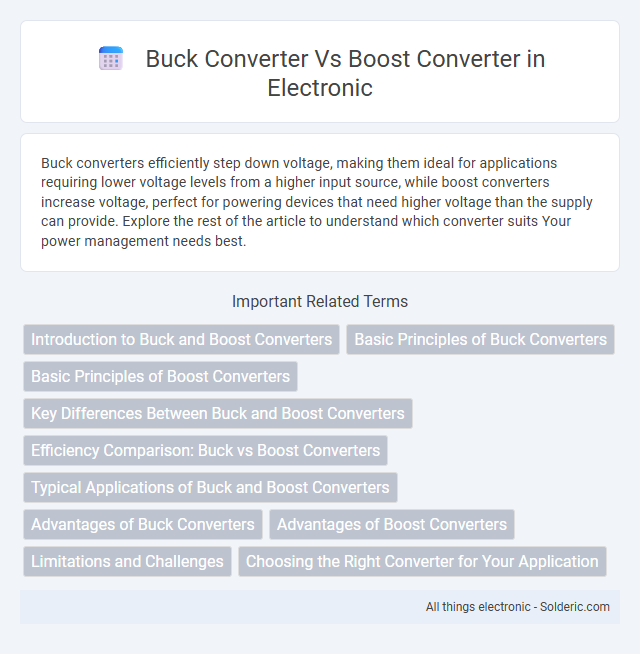Buck converters efficiently step down voltage, making them ideal for applications requiring lower voltage levels from a higher input source, while boost converters increase voltage, perfect for powering devices that need higher voltage than the supply can provide. Explore the rest of the article to understand which converter suits Your power management needs best.
Comparison Table
| Feature | Buck Converter | Boost Converter |
|---|---|---|
| Function | Steps down voltage (DC-DC step-down) | Steps up voltage (DC-DC step-up) |
| Output Voltage | Less than input voltage | Greater than input voltage |
| Efficiency | Typically 80-95% | Typically 80-90% |
| Inductor Current | Continuous (smooth current) | Discontinuous or continuous |
| Applications | Battery-powered devices, voltage regulation | Power supplies, LED drivers, battery charging |
| Complexity | Simple design, fewer components | More complex, needs careful control |
| Switching Element | Usually a MOSFET or transistor | Usually a MOSFET or transistor |
Introduction to Buck and Boost Converters
Buck converters are DC-DC converters designed to step down voltage efficiently by switching elements and energy storage components, commonly used in power supply regulation. Boost converters increase voltage from a lower input voltage to a higher output voltage using an inductor, diode, switch, and capacitor, ideal in battery-powered applications requiring voltage elevation. Both types utilize PWM control techniques to optimize power conversion and maintain output voltage stability.
Basic Principles of Buck Converters
Buck converters regulate voltage by stepping down higher input voltage to a lower output voltage using a combination of switching elements, an inductor, and a capacitor. The switch rapidly toggles on and off, controlling energy transfer and smoothing output voltage through the inductor and capacitor, which minimize ripple and improve efficiency. Your applications benefit from buck converters' ability to efficiently provide stable, reduced voltage levels required for sensitive electronic circuits.
Basic Principles of Boost Converters
Boost converters increase voltage from a lower input to a higher output by storing energy in an inductor and releasing it through a diode and capacitor when the switch turns off. The switch rapidly alternates between on and off states, controlling current flow and boosting voltage efficiently. Understanding these basic principles helps you select the right converter type for applications requiring voltage step-up.
Key Differences Between Buck and Boost Converters
Buck converters step down voltage by switching power from a higher input voltage to a lower output voltage with high efficiency, commonly used in battery-powered devices. Boost converters increase voltage from a lower input to a higher output voltage, essential in applications requiring voltage elevation like LED drivers and power amplifiers. Key differences include output voltage levels relative to input, operating principles--buck uses synchronous switching to reduce voltage, boost employs inductor energy storage and release to raise voltage--and efficiency variations depending on load conditions.
Efficiency Comparison: Buck vs Boost Converters
Buck converters typically achieve efficiencies between 85% and 95% due to their simple step-down voltage regulation, which minimizes power loss. Boost converters, while also efficient, generally range from 80% to 90%, as stepping up voltage often incurs higher conduction and switching losses. The efficiency gap is influenced by factors such as input voltage, output load, switching frequency, and component quality in each topology.
Typical Applications of Buck and Boost Converters
Buck converters are commonly used in power supply circuits for devices requiring a lower output voltage than the input, such as battery-powered electronics, LED drivers, and voltage regulation in computer motherboards. Boost converters find typical applications in scenarios needing higher output voltage than the input, including battery-powered fuel gauges, solar-powered systems, and portable devices where voltage step-up is essential. Both converters are integral in power management systems, optimizing efficiency for various load and voltage requirements.
Advantages of Buck Converters
Buck converters offer high efficiency in stepping down voltage, making them ideal for power-sensitive applications. Their simpler design results in lower component costs and reduced electromagnetic interference compared to boost converters. You can achieve stable output voltage with minimal power loss, ensuring reliable performance in battery-powered devices and embedded systems.
Advantages of Boost Converters
Boost converters offer the advantage of stepping up voltage from a lower input source to a higher output level efficiently, which is crucial for applications requiring increased voltage without altering current significantly. They provide high power density and improved energy efficiency due to reduced power loss during conversion. Your electronic designs benefit from compact size, lightweight components, and the ability to regulate output voltage precisely, making boost converters ideal for battery-powered devices and renewable energy systems.
Limitations and Challenges
Buck converters face limitations such as voltage drop under heavy loads and reduced efficiency at very low output voltages, while challenges include maintaining stable operation and minimizing electromagnetic interference. Boost converters struggle with increased input current ripple and potential instability during rapid load changes, complicating design for high step-up ratios. Both converters require careful selection of inductors and switching elements to balance efficiency, thermal management, and size constraints.
Choosing the Right Converter for Your Application
Selecting the appropriate power converter depends on your voltage requirements and efficiency needs; buck converters efficiently step down voltage for applications like battery-powered devices, while boost converters increase voltage for components requiring higher input levels. Buck converters offer simplicity and lower output ripple in applications demanding decreased voltage, whereas boost converters are ideal for scenarios needing voltage augmentation without a higher input source. Understanding load characteristics and input voltage range ensures optimized power conversion, reduced energy loss, and improved overall system performance.
buck converter vs boost converter Infographic

 solderic.com
solderic.com